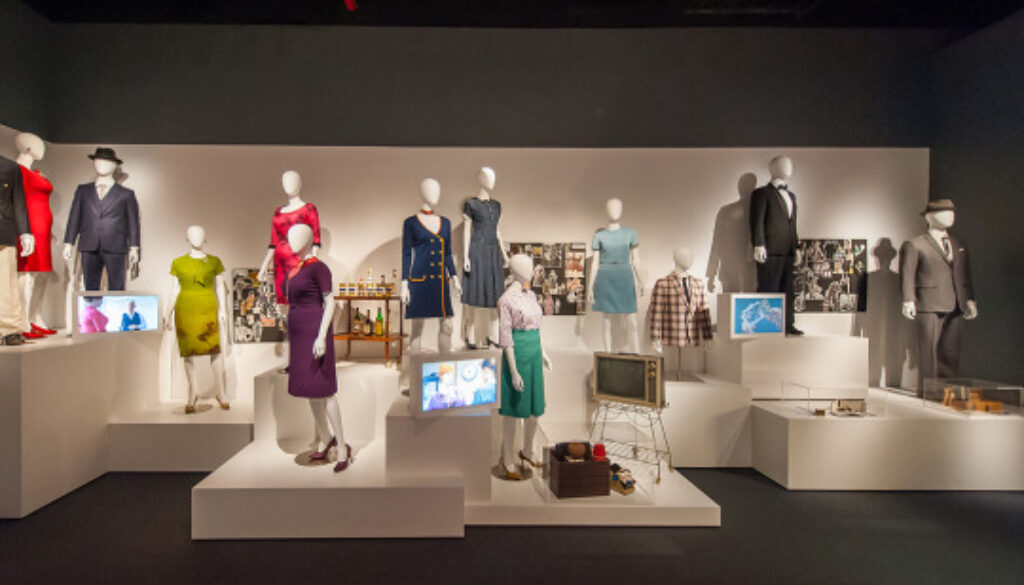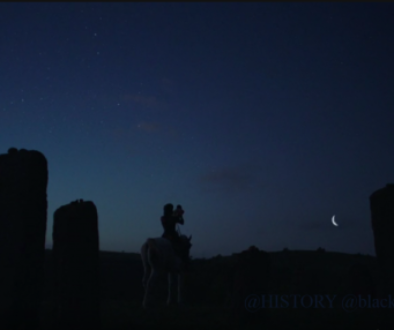Don Draper and Pals Come to Life in “Mad Men” Exhibit
(This article was originally featured on The Columbia Journalist on March 13, 2015)

(The installation “Matthew Weiner’s Mad Men” shows costumes and props for characters Don Draper, Peggy Olson, Joan Holloway Harris, and Roger Sterling. Photo: Thanassi Karageorgiou / Museum of the Moving Image)
Cheerful mod mini-dresses and gray flannel suits helped define an explosive decade and are now part of a new show at the Museum of the Moving Image celebrating the TV show “Mad Men.”
Props and sets used on the acclaimed AMC series go on view Saturday at the Museum of the Moving Image in Astoria. The exhibit, titled “Matthew Weiner’s Mad Men,” honors the creative process behind bringing the world of the 1960s to life. The exhibition is one part of several events this spring celebrating the series finale.
Set in the sexy, cut-throat world of Sterling Cooper & Partners, “Mad Men” depicts Madison Avenue’s advertising industry in the 1960s, a time of political and social tumult, and great cultural change. Sterling Cooper is a place where sex, drink and competition combine to make a provocative brew. Jon Hamm stars as Don Draper, an ad executive with a shadowy past and complicated life. The show, which has won 15 Emmy Awards, premiered in 2007. Television critics believe “Mad Men” is one of the most influential programs of the last decade.
Curator Barbara Miller worked with the AMC network and production company Lionsgate to bring hundreds of items from the Los Angeles sets to New York. Along with 33 costumes, two complete sets and hundreds of props, the exhibit also features reference materials from the show’s writer’s room. “Mad Men” creator Matthew Weiner gave the museum access to writers’ notes and early drafts.
There’s an ad hanging on the wall for Hershey’s chocolate bars. The price? 10 cents! There are also classic cereal boxes and old cans of baked beans displayed in glass cases.
Weiner, who created the iconic series, has loaned his notes from various stages of script development. They, too, are displayed in a glass case.
One characterization note on Pete Campbell, the infamous corporate climber at the ad agency, reads, “Pete can’t drive.” It’s a reference to the episode in which Campbell crashes a test model car. Another note says, “production moves to consumption,” referring to how much of ’60s advertising was aimed at selling commodities people didn’t necessarily need but wanted to have,
Along the walls next to the case are Weiner’s journal entries tracking as far back as the early 1990s when he first developed the ideas that would become “Mad Men.” One page from January 1993 reads, “Surely if he [Don Draper] leaves two families, they should have some … in his future. Take his long lost brother Adam. What becomes of him?”
Fans seeking clues or spoilers as to how “Mad Men” will end later this spring will be disappointed.
“They didn’t show them to us and we didn’t ask for them,” said Carl Goodman, the museum’s executive director.
But those looking for behind-the-scenes tidbits about their favorite characters and scenes will find a lot at the museum.
The first large display in the exhibit is the series’ writer’s room. The space that represents the heart of the foundation for the series is given just as much importance as the sets and costumes. There’s a shelved wall filled with reference books on ‘60s history, advertising and culture. The back wall has whiteboards with staging direction notes and photos of each major character taped to the wall. On the long meeting desk sits a MacBook, current trade magazines, notepads and a vintage bubble gum box to remind the writers that they are writing about the past.
The soundtrack to the section of the exhibit where the majority of the costumes are displayed is Megan Draper’s rendition of “Zou Bishou Bishou.” Don’s box of secrets from his life as Dick Whitman is the hidden highlight of the room. Fans will instantly recognize proof of his divorce from Anna as well as his Korean War mementos. Betty’s house clothes, Pete Campbell’s preppy business suits and the dresses Joan wears that cinch her hourglass figure are also featured.
Jane Bryant, the TV show’s costume designer, allowed the museum to set up her reference boards next to each costume. Each board has photos of previous outfits and fabric swatches as well as similar styles from the period.
The Draper kitchen set from seasons 1 through 4 and Don’s office from seasons 4 through 6 are must-sees for fans. Everything from half-eaten Utz potato chips to the wooden dining table is included. Most of the kitchen props date from earlier than the show’s official timeline to reflect the many years Don and Betty were married. Don’s office is carefully arranged to show ashtrays, paperwork and the ubiquitous liquor cart.
Concurrent with the exhibit, the museum is screening a film series called “Required Viewing: Mad Men’s Movie Influences,” from March 14 to April 26.
Weiner curated a list of 10 movies that he says influenced his vision for the show. They include Alfred Hitchcock’s stylish thriller “North by Northwest,” starring Cary Grant, who cuts a suit as dandily as Draper and has the same slicked back hair; Billy Wilder’s “The Apartment,” which stars Jack Lemmon as an up-and-coming exec who lets his bosses use his apartment for affairs; and “The Bachelor Party,” a 1957 story written by Paddy Chayefsky about a night of drinking and discovery.
“Matthew Weiner’s Mad Men” runs at the Museum of the Moving Image through June 14.



